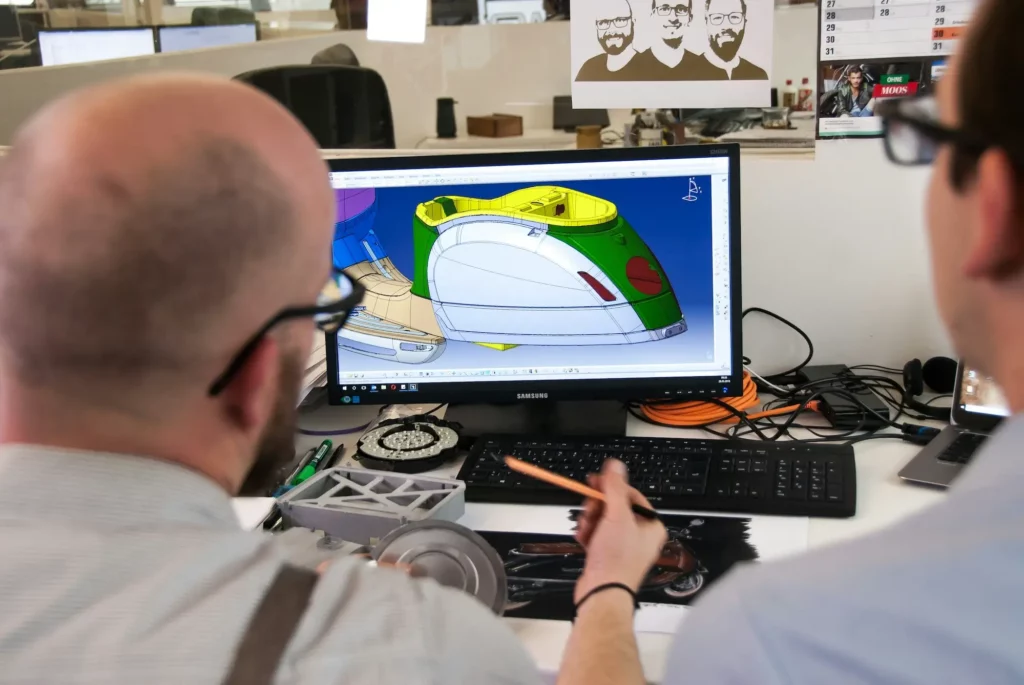Working together has always been at the heart of successful organizations. But with remote work becoming more common, the need for clear communication channels and easy-to-use collaboration platforms is stronger than ever.
Team collaboration tools give employees a simple way to share knowledge, manage projects, and stay connected. They can help improve team alignment, support better decision-making, and make the whole work experience smoother.
Let’s look at your top choices of internal collaboration tools in this article.
7 Internal Collaboration Tools Summary Table
Here’s a quick look at the tools that can help you and your team improve internal collaboration.
| Tool | Best For | Key Collaboration Features |
| CADchat | Presenting and reviewing CAD files | Live CAD reviews, async comments, centralized workspace, whiteboards, version control |
| Slack | Communication and project collaboration | Instant messaging, group chat, project channels, app integrations, direct messaging |
| Dropbox | File sharing and content management | Secure file sharing, easy access, remote team support, app integrations |
| ClickUp | Project and task management | Shared tasks, project planning, team docs and chat, Google/Microsoft integrations, workflow management |
| Notion | Internal wiki and knowledge sharing | Knowledge base, collaborative docs, resource tracking, app integrations, knowledge sharing |
| Quickbase | Tracking project progress | Project timelines, milestones, centralized management, third-party integrations, productivity automation |
| Zoom | Webinars and team workshops | Video meetings, collaboration tools, meeting summaries, team chat, app integrations |
7 Best Internal Collaboration Tools in 2025
Collaboration at work looks very different in 2025. Teams now depend on digital platforms to share files, manage projects, and stay connected no matter where they are.
The right collaboration tools not only save time but also help teams stay organized and work better together.
Let’s look at the best internal collaboration tools in 2025 that can help your team stay productive and connected.
1. CADchat for Presenting CAD Files
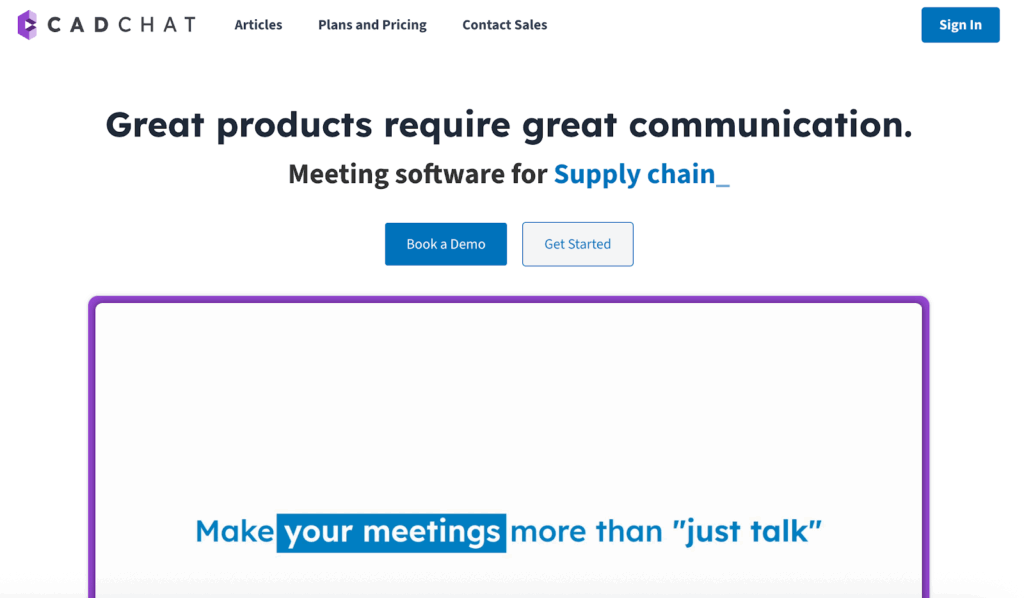
CADchat is a meeting platform built to support team collaboration on CAD projects. Your entire team can meet inside one centralized workspace.
Engineers, designers, and non-technical team members can review CAD models together, leave input, and move projects forward without confusion. By keeping communication connected to the actual design, CADchat makes reviews faster and decisions clearer.
It also gives flexibility for both live and asynchronous work. Teams can host real-time sessions with virtual whiteboards to highlight details or leave comments directly on models for others to review later.
Every file, note, and change is stored in the same workspace with version control, so all team members always know they are working on the latest design.
Key Features
- Live CAD model reviews – Open and inspect 3D CAD files together with no screen sharing needed
- Asynchronous collaboration – Leave comments on models so feedback is clear and always attached
- Centralized workspace – Store files, notes, and conversations in one place for the entire team
- Virtual whiteboards – Highlight design details during live reviews for clearer discussions
- Stakeholder access – Non-technical team members, stakeholders, and suppliers can view models and share input without CAD expertise
- Version control – Keep track of all changes and always work on the latest file version
- Change tracking – Every decision and edit is logged, so the team has a full record of updates
Collaborate on CAD designs without the back-and-forth. Start using CADchat today!
2. Slack for Quick Team Chats and Updates
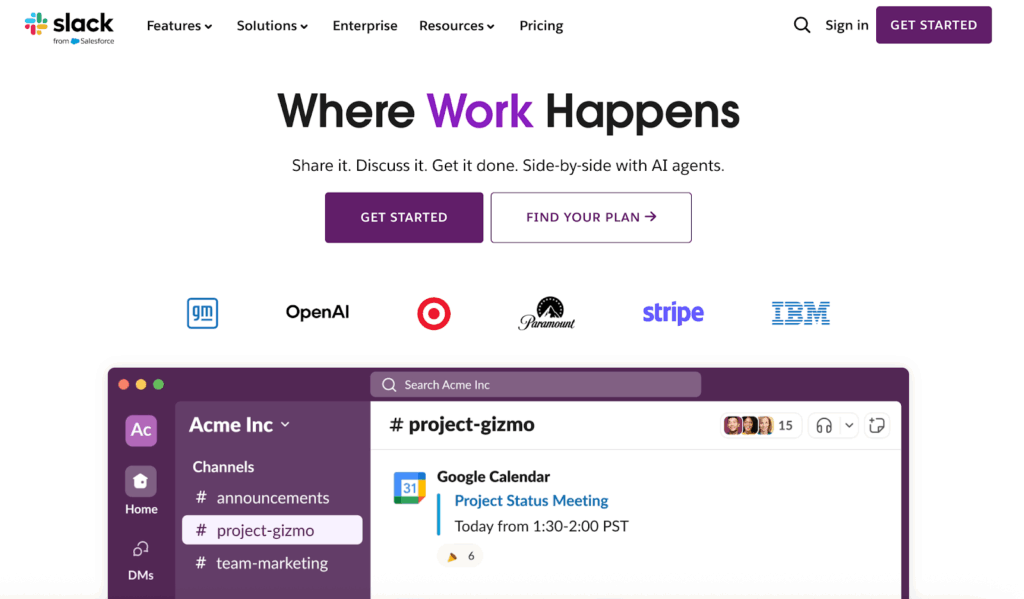
Source: slack.com
Slack is a centralized platform that helps remote and hybrid teams stay connected through instant messaging, project collaboration, and powerful communication features.
Teams can share updates, hold group chat discussions, and keep projects moving in one place. It supports direct messaging for quick check-ins as well as larger channels where multiple users can collaboratively create plans, share files, and manage tasks together.
Beyond daily chats, Slack can also strengthen company culture by giving teams an easy way to celebrate wins, share news, and stay engaged. With integrations like Google Calendar, teams can connect schedules directly into conversations, keeping work more organized.
Slack makes internal communication faster and simpler, which helps reduce unnecessary meetings and lets businesses expand without losing alignment across teams.
Key Features
- Instant messaging – Keep hybrid teams connected with quick, real-time conversations
- Group chat and direct messaging – Support both team-wide discussions and private communication between team members
- Project collaboration – Share ideas, assign tasks, and keep projects moving from start to finish
- Centralized platform – Bring files, tools, and updates into one hub where multiple users can work together
- Communication features – Use channels, integrations, and notifications to strengthen internal communication and company culture
3. Dropbox for File Sharing
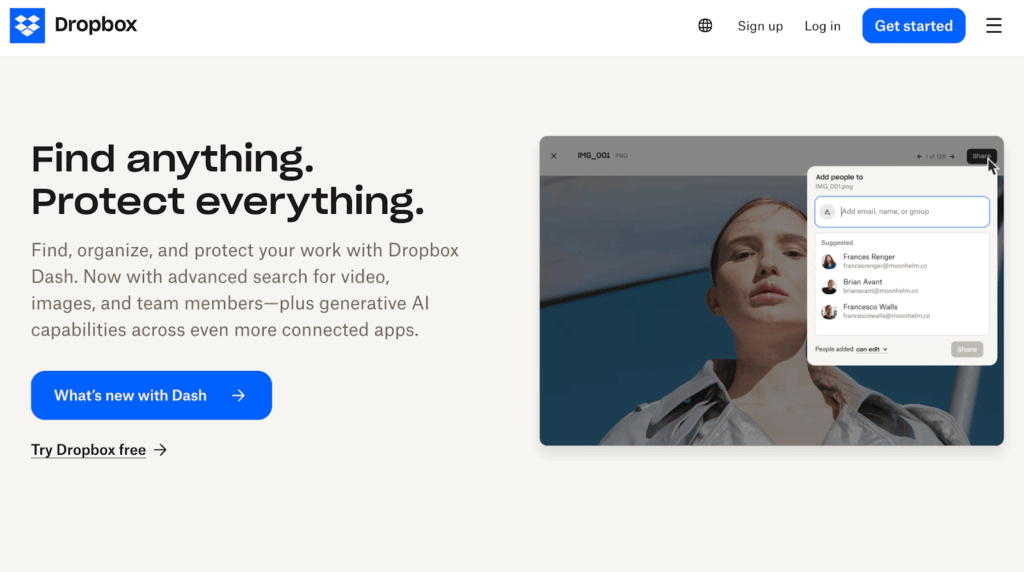
Source: dropbox.com
Dropbox makes file sharing simple and secure, giving remote teams and in-office staff easy access to the content they need.
You don’t have to lose time searching through emails or scattered folders. With Dropbox, you can easily find, organize, and share files from one place.
Team members can connect different apps, preview files instantly, and share secure links without extra steps. With version history and recovery built in, everyone works on the most updated content.
For companies managing large projects across multiple departments, Dropbox creates a centralized space where collaboration is faster, safer, and easier for all.
Key Features
- File sharing – Share large files securely with links and real-time syncing
- Easy access – Organize content in one hub where employees can quickly find what they need
- Remote teams – Support collaboration across locations with cloud-based storage
- Various tools – Integrate with connected apps to simplify everyday work
- Employee engagement – Keep teams aligned with secure, organized, and accessible content
4. ClickUp for Project Management
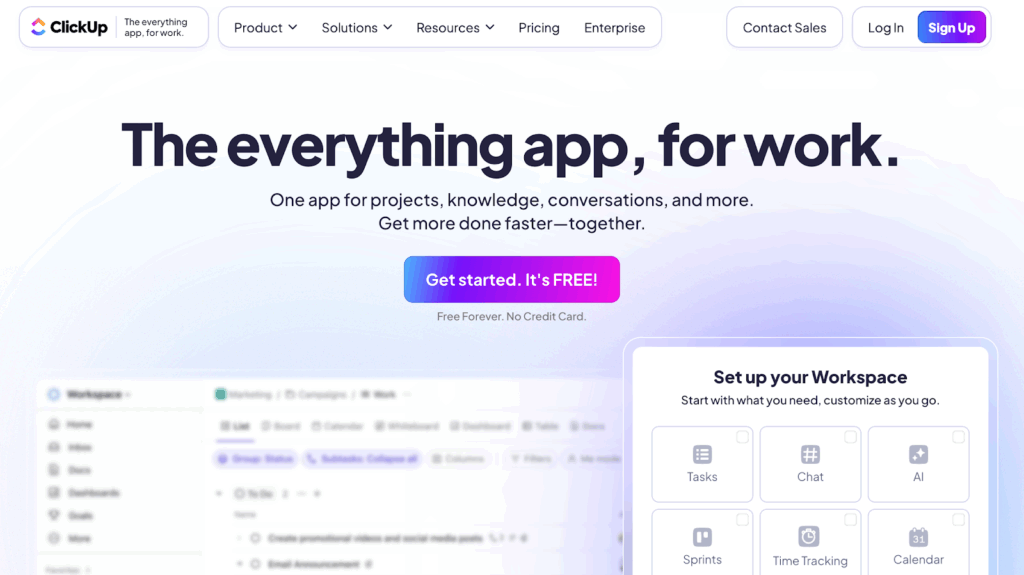
Source: clickup.com
ClickUp is an all-in-one project management software that enables teams to plan, track, and complete work together in one place, simplifying workflow management so projects move faster and fewer details are lost.
This project management tool helps hybrid and remote teams stay aligned with features such as task management, time tracking, workflow automation, and dashboards in a single workspace.
Its flexibility allows teams to connect with tools they already use, like Google Workspace and Microsoft Teams, making collaboration smoother.
Whether it’s a marketing team planning campaigns or engineering teams running sprints, ClickUp makes project planning easier by keeping everyone on the same page.
Key Features
- Shared task management – Assign and track tasks in views that the whole team can access
- Collaborative project planning – Plan goals and milestones with features that keep teams aligned
- Team docs and chat – Collaboratively create documents and hold discussions inside the same workspace
- Integrations with Google Workspace and Microsoft Teams – Keep updates and files connected across platforms
- Workflow management – Coordinate sprints, deadlines, and workloads to keep collaboration on track
5. Notion as an Internal Wiki for Teams
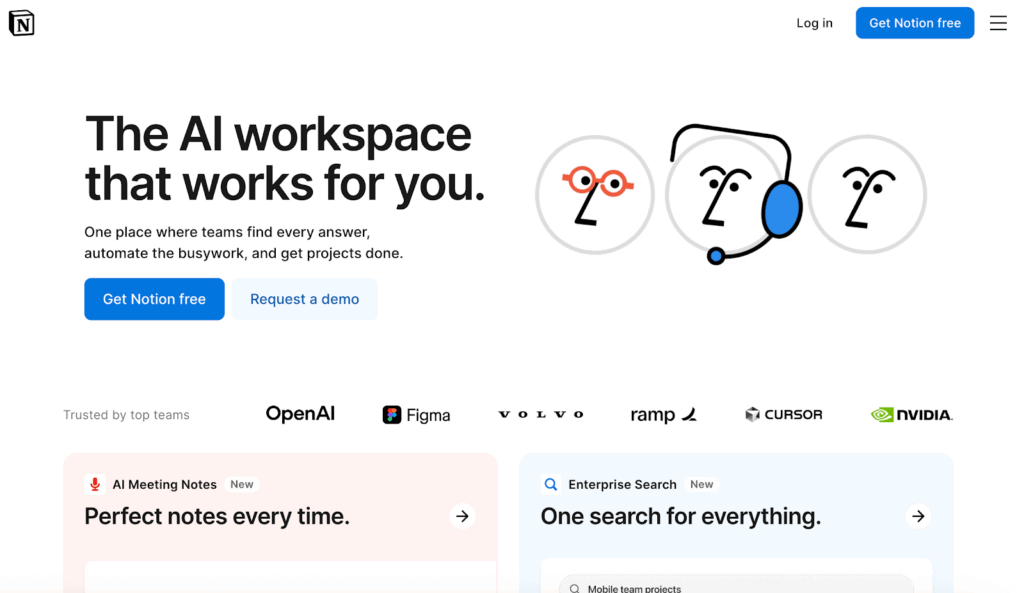
Source: notion.com
Notion is an AI workspace commonly used as a knowledge management hub that lets teams share knowledge, document processes, and organize tasks in one place. It supports team collaboration and knowledge sharing across departments.
From onboarding documents to project plans, it provides structure for resource management while giving every team member the ability to collaboratively create, edit, and update content.
This makes it easier for everyone to find answers, share files, and contribute to collaborative content management without switching between multiple apps.
With seamless integration into platforms like Slack, Google Drive, and Microsoft Teams, Notion becomes the central space where teams manage resources and stay aligned.
Key Features
- Knowledge management – Store and organize team knowledge in one searchable wiki
- Collaborative content management – Create and edit documents together in real time
- Resource management – Track projects, goals, and shared resources across teams
- Seamless integration – Connect with tools like Slack, Google Drive, and Microsoft Teams
- Knowledge sharing – Share files, notes, and updates so teams can stay aligned
6. Quickbase for Tracking Project Progress
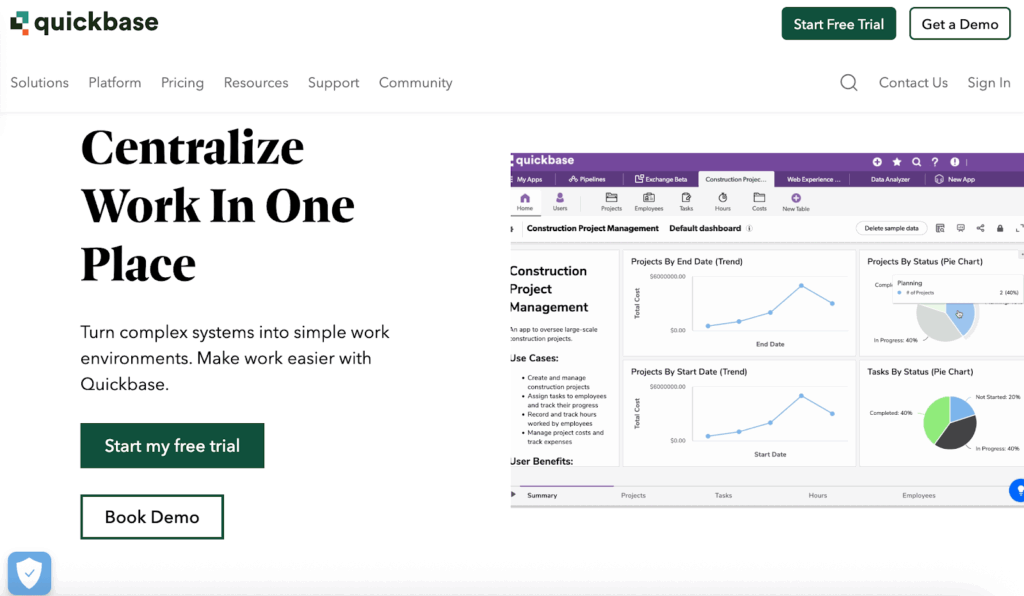
Source: quickbase.com
Quickbase is a work management platform that helps teams centralize projects, connect systems, and improve productivity. It is designed to simplify complex workflows so teams can stay aligned on project timelines, project milestones, and business objectives.
By bringing everything into one platform, Quickbase makes it easier for teams to collaborate, monitor progress, and adapt quickly when plans change.
The platform also integrates with third-party tools and existing software, which reduces the learning curve for new users.
You can connect data from different sources, track work in real time, and eliminate manual processes that slow projects down.
Key Features
- Project timelines – Visualize work across teams and stay aligned on deadlines
- Project milestones – Track critical checkpoints that connect directly to business objectives
- Work management platform – Centralize tasks, resources, and updates in one shared space
- Integration with third-party tools – Connect existing software to streamline processes
- Improve productivity – Automate workflows and reduce manual work for faster progress
7. Zoom for Internal Webinars and Team Workshops
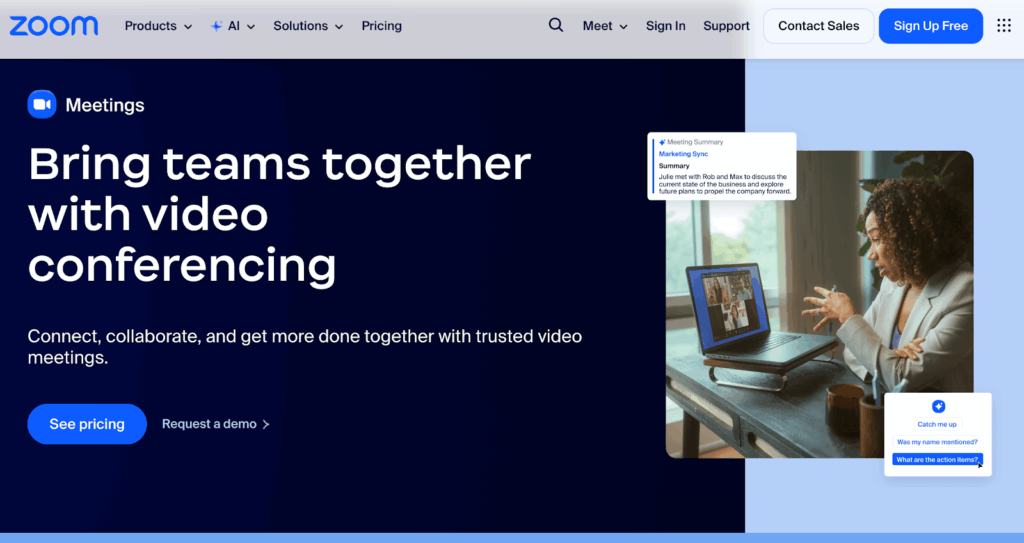
Source: zoom.com
Zoom is one of the most trusted video conferencing tools for team meetings, internal webinars, and workshops.
It works as more than just a video conferencing solution. Zoom connects people across locations, making it easier to share ideas, solve problems together, and keep everyone on the same page.
When combined with a project management app or other integrations, Zoom helps teams turn discussions into action. Participants can assign tasks, capture meeting notes, and use AI-powered summaries to enhance transparency across the company.
With built-in features that keep everyone aligned, Zoom makes internal workshops more interactive and ensures that important ideas are captured and turned into action.
Key Features
- High-quality video meetings – Host secure webinars and team sessions with clear audio and video
- Built-in collaboration tools – Use whiteboards, polls, and chat to support real-time teamwork
- Meeting summaries and action items – Capture key points so everyone leaves with the same understanding
- Ongoing team chat – Continue conversations before and after meetings without losing context
- Integrations with other apps – Connect Zoom with tools your team already uses to keep collaboration in one place
Review CAD models, leave comments, and track progress. All in CADchat. Book your demo today!
Why Internal Team Collaboration Software Matters at Work
As work becomes more connected and often remote, internal collaboration has become a key part of how teams stay in sync. Here’s why online collaboration tools matter at work today.
Improves Productivity
Productivity rises when employees use online collaboration tools rather than relying on scattered emails or face-to-face updates.
A shared space where people can upload documents, check progress, and comment on tasks saves valuable time.
For example, a marketing team working on a campaign can upload draft content, get quick feedback from designers, and move projects forward without long delays.
Keeping everything in one place reduces confusion and allows employees to focus on their actual work rather than chasing updates.
Supports Better Decision Making
Decisions often go wrong when people lack the right data or context. Collaboration platforms solve this by storing past decisions, giving everyone a clear history to reference.
If a product team is debating a feature, they can check old discussions, review why certain choices were made, and avoid repeating past mistakes.
Messaging apps make it easy to connect with subject matter experts quickly, no matter where they are. This builds a culture where decisions are based not on mere guesswork, but on shared knowledge.
Drives Action Across The Team
It’s easy for projects to stall when no one knows who should act next. Collaborative tools prevent this by showing everyone what tasks are in progress and what still need attention. Team alignment improves when employees can see their role in the bigger picture.
This is especially helpful in a remote work setup. Tools like project management platforms can display task deadlines and ownership, which motivates people to take action.
Seeing colleagues actively moving tasks forward also inspires others to contribute, keeping projects alive and moving.
Builds A Better Employee Experience
Outdated systems drain energy, while modern communication tools create a more positive work experience.
Employees want tools that make their daily tasks easier and allow them to collaborate without stress.
A team knowledge base gives workers instant access to answers, helping them avoid repeating the same questions. This saves time and keeps frustration low.
When people feel supported with the right collaborative tools, their engagement improves, and they are more likely to enjoy coming to work.
Strengthens Workflow Process
A clear workflow makes teamwork more efficient. Collaboration tools provide this clarity by outlining the steps and standards for how tasks should be done.
Employees do not have to guess because they know what is expected and how they can contribute. Online collaboration tools can outline every stage from planning to testing.
Everyone knows their tasks, deadlines, and who to contact if issues arise. This structure helps teams finish projects consistently and with fewer errors.
Improves Problem Solving
Fresh challenges are part of every workplace. The difference is how teams respond to them. With collaborative tools, brainstorming happens faster and involves more voices.
A group can gather on a video call, use shared documents, or chat through messaging apps to suggest and refine ideas. Having access to past solutions also means employees don’t start from zero each time.
Online collaboration tools are very helpful for the customer service industry. If a service issue reappears, staff can check how it was solved before and build on that solution instead of repeating old mistakes.
Make your CAD meetings interactive, not one-sided. Contact CADchat to learn how.
Makes Knowledge Sharing Easier
When knowledge is trapped with one person, projects slow down. Communication tools and shared platforms solve this by making knowledge open to all.
Sales teams can use a knowledge base to share pitch templates, customer questions, and successful strategies. No more waiting for the same colleague to explain the process; new hires can read guides and start contributing faster.
Over time, this builds a stronger organization because everyone can access and add to the shared pool of knowledge.
Helps With Record Keeping And Compliance
Many organizations need to keep proper records to follow legal or industry rules. Team collaboration tools make this easier by storing conversations, documents, and project details.
Without these records, companies risk making costly mistakes or missing important requirements.
Digital communication tools help teams stay organized and compliant while keeping projects moving.
Gives Employees More Control
Internal collaboration tools put structure into daily work. Employees can see their priorities, managers can assign tasks, and files are easy to locate.
In a design agency, project boards can show which designer owns which task, what deadlines are coming up, and who is reviewing the final product.
Messaging apps allow quick clarifications without long meetings. This level of control creates less chaos and more order, which helps both managers and employees feel confident about progress.
Collaborate Smarter on CAD Files with CADchat
When teams work on complex designs, clear internal CAD collaboration can make all the difference.
CADchat gives your company one space where designers, engineers, and other departments can connect, review, and share feedback without confusion. By keeping everything tied directly to CAD files, your team saves time and avoids mistakes that often come from scattered tools.
This design review software also helps keep communication focused. Your team can review 3D designs in real time or leave feedback asynchronously.
Every idea, comment, and version stays connected to the right project, so nothing gets lost and everyone stays aligned on what matters most.
FAQs About Internal Collaboration Tools
What is internal collaboration?
Internal collaboration is when people within the same company or team work together to share ideas, complete tasks, and reach common goals.
It usually involves open communication, knowledge sharing, and using tools that help everyone stay connected and aligned.
What are the different types of collaboration tools?
Collaboration tools come in many forms, such as messaging apps for quick chats, project management software for tracking tasks, file-sharing platforms for documents, and video conferencing tools for meetings.
Each type is designed to make teamwork easier and more organized.
What are the 4 models of collaboration?
The four models of collaboration are team collaboration, where members work closely on shared goals. Community collaboration involves larger groups sharing knowledge.
Network collaboration happens when different groups connect to exchange ideas. Alliance collaboration usually takes place between organizations working together.
What is the best tool for collaboration?
The best tool depends on what a team needs, but the most effective ones are simple, easy to use, and flexible. They should make communication, file sharing, and project tracking smooth for everyone.
If you’re working with CAD files, CADchat is a strong option because it brings these features together in one platform.
